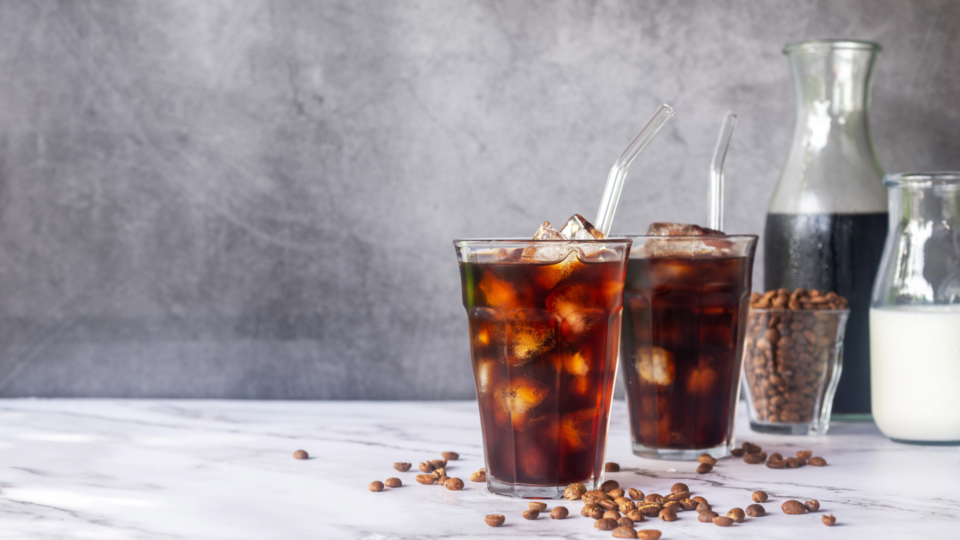What is cold brew? It’s taken the world by storm—and for good reason. It’s smooth, refreshing, and surprisingly easy to make. Whether you’re a seasoned coffee lover or just looking for a chilled caffeine fix for the summer, cold brew is a fantastic option that fits right into busy lifestyles and wellness routines. In this post, we’ll cover everything from how to make it at home to why it’s more than just a trendy drink—it’s a genuinely versatile, feel-good beverage with a few unexpected perks.
What is the best way to make cold brew coffee?
Making cold brew is extremely simple once you understand the basics, and it can be made at home, in the office, or anywhere you’ve got access to a fridge! Let’s break down everything you need to make your own cold brew at home:
- Coarsely ground coffee beans.
When you’re grinding your beans, aim for a texture that resembles rock salt rather than the fine consistency you’d use for espresso. No grinder? No problem—just look for pre-ground coffee labelled for cold brew or French press use. - What kind of coffee is best for cold brew?
The best coffee for cold brew is ultimately down to personal taste, so we recommend you do some experimenting to find your favourite. If you’d like our recommendation, we find the best coffee to be illy’s Classico blend, made from 100% Arabica. Arabica is naturally lower in caffeine than Robusta, which might just knock your socks off in a cold brew (keep reading: all will be explained!). Plus, the rich, bold flavours of a darker roast, which can sometimes get lost in espresso, really shine through in cold brew. - What is the coffee to water ratio for cold brew?
Add 1g of coffee for every 8ml of water (1:8 coffee to water) to your container. This could be a mason jar, jug, French press, or a dedicated cold brew maker. Pour in the (ideally filtered) water and give it a gentle swirl to make sure all the grounds are saturated, and you’re good to go. - Pop it in the fridge for 12 to 24 hours. Cold water extracts flavours much more slowly than hot water, so patience is key—but trust us, it’s worth the wait.
- Filter and serve over ice. Once your brew time is up, strain the grounds using a paper filter or French press plunger, and pour your cold brew over ice. Feeling fancy? Try shaking it with brown sugar and oat milk or adding a splash of caramel syrup for a sweet treat.
What’s the difference between coffee and cold brew?
Naturally Sweeter Taste
That’s right—cold brew has a naturally smoother, sweeter flavour compared to hot-brewed coffee. The acids and oils responsible for bitterness in hot brews are extracted much more slowly in cold water, allowing more delicate, aromatic notes to shine through.
Higher Caffeine Content
While caffeine levels vary depending on your coffee-to-water ratio and bean type, cold brew generally contains more caffeine. That’s because caffeine dissolves easily in water—even cold—and the long brewing time allows more of it to be extracted.
What’s the difference between cold brew and iced coffee?
Whether the additional caffeine content is a benefit or a drawback really depends on your tolerance. If you’re sensitive to caffeine but still want a chilled option, go for decaf beans or switch to iced coffee, which is made with hot espresso poured over ice and has a caffeine level on par with other espresso-based drink such as lattes.
The ideal pre-workout beverage
If you’re still wondering “what is the point in cold brew coffee?” this is it. Thanks to its higher caffeine content, cold brew can give you that energy boost you need to smash your workout. It’s also incredibly convenient for early starts—just grab it from the fridge and go. No boiling kettles, no cooling time, just straight-up fuel.
It’s Gentler on Sensitive Stomachs
If traditional coffee leaves your stomach feeling sore, cold brew might be the answer. Its lower acidity makes it easier on digestion, making it a more comfortable choice—especially before exercise. Because let’s face it, nobody wants to be dealing with acid reflux mid-burpee.
Aids in Weight Management
Cold brew might also lend a helping hand in your weight management journey. The extra caffeine can help speed up metabolism and reduce appetite, while the naturally sweeter taste means you’re less likely to load it up with milk and sugar. While you’re unlikely to shed pounds from simply drinking coffee, it can be a handy tool when paired with a balanced diet and exercise.
Versatile Ingredient for Recipes
Don’t have an espresso machine but would love to make a tiramisu or a coffee cake? Cold brew concentrate is a brilliant alternative. Simply increase the coffee-to-water ratio to around 1:2 or 1:5, and follow the same brewing steps. You’ll have a rich, strong coffee base perfect for desserts, iced lattes, or even DIY frappuccinos. If you’re curious what is the best coffee to make cold brew, go for a strong, full-bodied roast that can stand up in recipes.
Conclusion: What is cold brew?
So, what is the best cold brew coffee? That depends on your taste—but medium to dark roast coffees tend to shine. Whether you’ve been searching for what roast of coffee is best for cold brew, what is the best cold brew coffee maker, or just trying to understand what is the difference between cold brew and cold coffee, now you’ve got all the basics.
Cold brew is more than a trend—it’s a smoother, more versatile way to enjoy coffee. Whether you’re sipping it solo, using it to power through workouts, or stirring it into dessert recipes, it’s a fantastic addition to any routine. So next time someone asks what kind of coffee is best for cold brew or what is the difference with cold brew coffee, you’ll be ready with all the answers—and maybe even a homemade batch to share.

